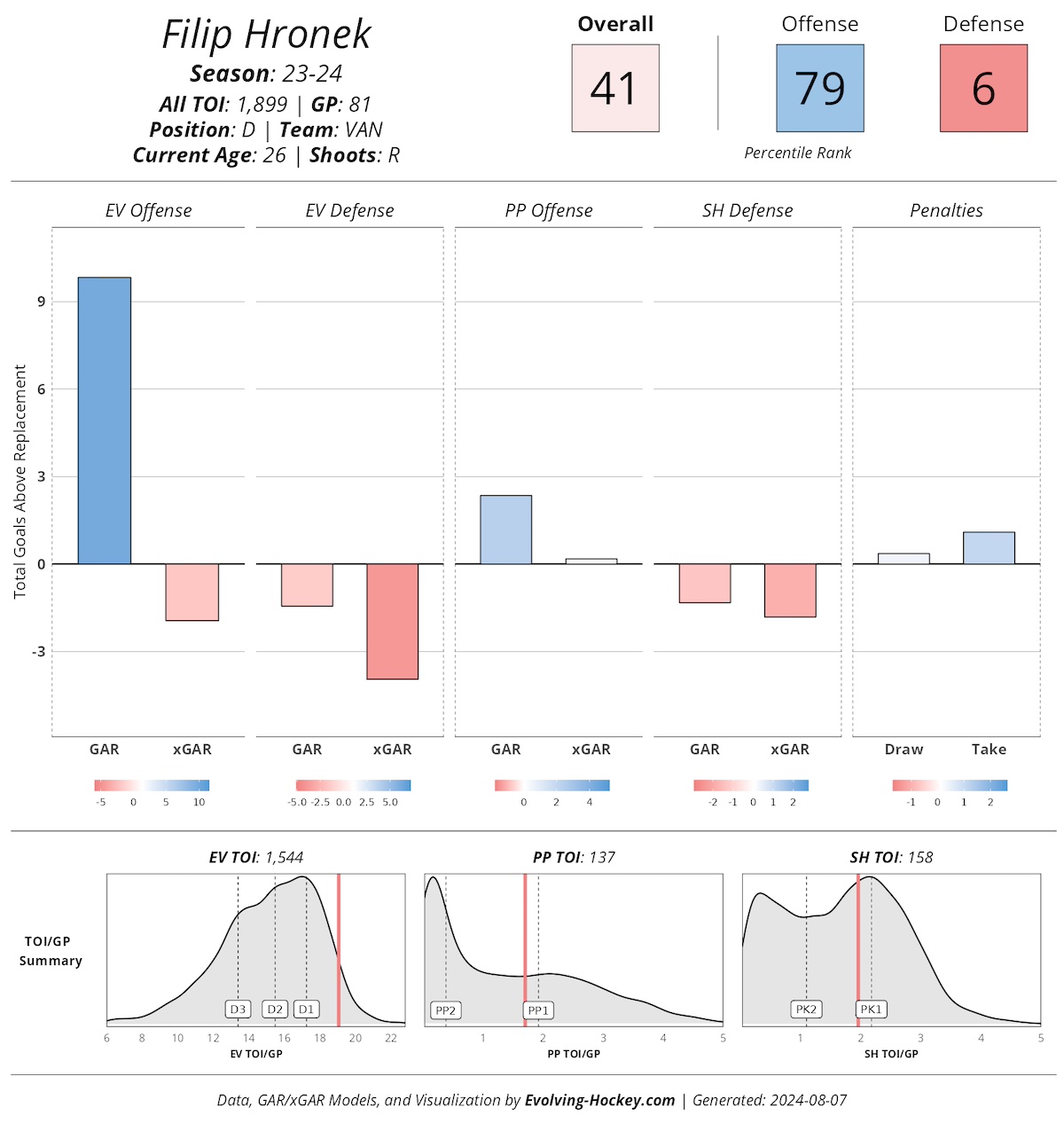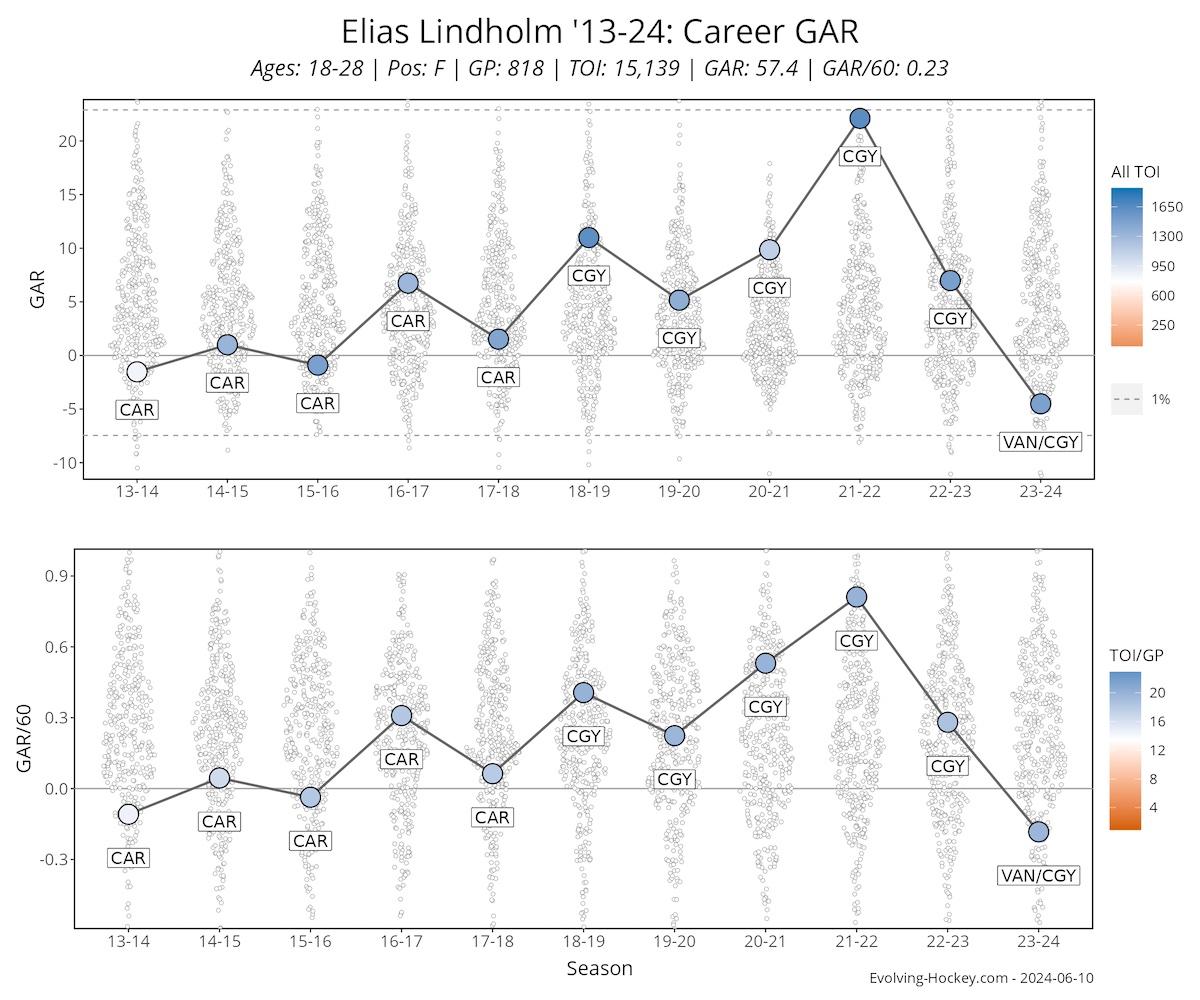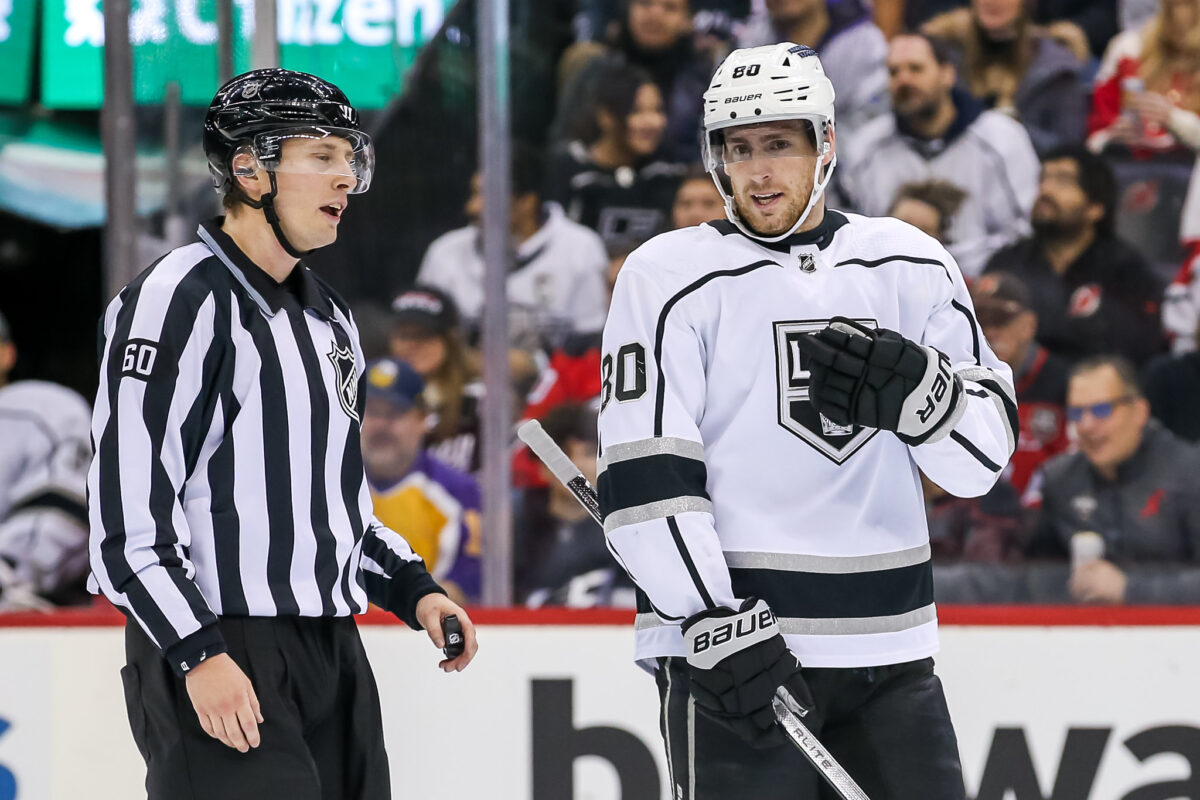Earlier this week, we looked at some of the best contracts in the NHL based on recent performance and how they project to age in the coming years. Today, we’ll be flipping course and looking at some of the worst contracts based on recent performance and how they could age. Let’s get right into it.
10. Mikhail Sergachev
Contract: 7 years remaining, $8.5 million cap hit
There’s probably a reason the Tampa Bay Lightning moved on from Mikhail Sergachev only a year after he signed an eight-year extension worth $8.5 million annually. Injuries played a part in his struggles this past season; he only appeared in 34 games. Still, aside from an excellent season in 2022-23, there’s not much to suggest he’s an $8.5 million player.
Related: NHL’s 10 Best Contracts for 2024-25
Sergachev finished the 2022-23 season with 64 points in 79 games, shattering a previous career-high of 40 he set as a rookie in 2018-19. But that in itself is a red flag. While Sergachev had been a steady point producer before 2022-23, he averaged 40 points per 82 games. Of course, in a contract year, he popped for 64 points, well off from his career averages.
Sergachev also set a career-high in goals above replacement (GAR) at 12.4 and wins above replacement (WAR) at 2.1 in 2022-23. Otherwise, he’s been around a 0.5 to 1.0 WAR player for his career. Is that an $8.5 million player? Utah HC seems to believe he is, and he’ll likely be on their top pair alongside John Marino. But the fact the Lightning cut bait so quickly after signing him to that massive extension should raise eyebrows.
9. Darnell Nurse
Contract: 6 years remaining, $9.25 million cap hit
It’s not that Darnell Nurse is a bad player. He’s not, but it’s hard to argue that he’s worth $9.25 million or ever get to a point where he’s worth his contract. His production over the last three seasons has been solid, averaging 39 points per 82 games. But even for a defenseman, that’s not worth $9.25 million annually.
Nurse’s underlying metrics suggest similar as well. He hasn’t recorded a GAR higher than 4.1 or a WAR higher than 0.7 over the last three seasons. Given where he is in his career, chances are those numbers won’t improve to where he’s worth $9.25 million. If the Oilers could find a way to clear his contract, they probably would since they’re tight on the cap. But it looks like they’ll be stuck with his deal for the foreseeable future.
8. Filip Hronek
Contract: 8 years remaining, $7.25 million
The Vancouver Canucks have gotten smarter about team building since Patrik Allvin and Jim Rutherford have taken over the front office, but they still can’t seem to avoid that one bad contract. I can’t blame them for paying Filip Hronek this offseason. He had a great year alongside Quinn Hughes, but I’m not sure that great season is sustainable.
Hronek finished this past season with a GAR of 10.9 but an expected GAR (xGAR) of minus-6.9. That suggests there was a lot of flukiness in his results, and there’s more evidence of that. His on-ice shooting percentage of 11.9 percent at five-on-five was the highest of his career, and 19 of his 30 assists at five-on-five were secondary helpers.

I get wanting to keep Hughes’ defense partner locked up long-term, but there are plenty of red flags to suggest what Hronek did in a contract year isn’t sustainable. He’s been a middle-of-the-lineup defenseman for most of his career, and is likely to revert to that. That’s not someone worth $7.25 million annually.
7. Sean Couturier
Contract: 6 years remaining, $7.75 million cap hit
The Philadelphia Flyers are in rebuild mode and have cleared many bad contracts they had on the books. But unfortunately, one of the rare bad contracts on their cap is one of the worst in the NHL. Injuries have hampered Sean Couturier’s career, and while his impacts were quite good this past season, it’s difficult to argue he’s a $7.75 million player anymore.
Couturier’s underlying metrics were solid last season. His play was worth a total GAR of 8.7 and a WAR of 1.4 across 74 games, but he only totaled 38 points, which is not $7.75 million worthy. Given the nature of his injuries, plus him turning 32 this coming season, this isn’t a contract that will likely age well. Sure, the underlying metrics may still hold up, but many of these contracts get judged by counting totals.
Unfortunately, the Flyers are probably stuck with this deal for the foreseeable future. No team will take it off the books without significant retention, something the Flyers likely don’t want to do, given how many years remain on it. And a buyout isn’t plausible for a few more years at a minimum.
6. Elias Lindholm
Contract: 7 years, $7.75 million cap hit
Elias Lindholm has yet to play a game under his new contract for the Boston Bruins. But the decline in his performance over the last two years raises some serious red flags that he’ll live up to the dollar amount the Bruins paid him. Lindholm’s production has slipped in each of the last two seasons from 82 to 64 points in 2022-23 and just 44 points this past season.
But it’s not only Lindholm’s production that has slipped. His underlying metrics have fallen off a cliff, too. His xGAR has decreased from 22.4 to 4.6 to minus-9 over the last three seasons, lining up with his actual GAR falling from 22.1, 7, and minus-4.5:

Is Lindholm as bad a player as he was this past season? Probably not, but it’s hard to envision a scenario where he lives up to the $7.75 million cap hit the Bruins paid him. The hope is that he clicks with David Pastrnak and refinds his game again, but that’s far from a certainty.
5. Seth Jones
Contract: 6 years remaining, $9.5 million cap hit
Seth Jones has been better than I thought he would for the Chicago Blackhawks, but he’s not close to a $9.5 million defenseman right now. His production over the last three seasons — 45 points per 82 games — has been solid, but that’s partly inflated due to a 51-point season he had in his first year with the Blackhawks before his extension kicked in.
Since then, Jones hasn’t totaled more than 37 points in a season. I’d guess that’s partly because the Blackhawks stripped it down to the bolts to rebuild. But even then, Jones has not lived up to the massive extension former GM Stan Bowman gave him before getting fired.
Jones’ play has been worth a total GAR of 16.7 and a WAR of 2.8 over the last three seasons. He’s been perfectly fine, but that’s not worth $9.5 million annually. No one would mention anything about his contract if he were making $5-6 million a year, but that’s not the case. Perhaps he will come closer to his deal’s value as the Blackhawks move forward with their rebuild and start competing. But there’s a long way to go before that comes to fruition.
4. Tom Wilson
Contract: 7 years remaining, $6.5 million cap hit
Tom Wilson’s game has started to drop off in recent years, but that didn’t seem to matter to the Washington Capitals. They re-signed him to a seven-year extension worth $45.5 million that will kick in for this coming season. But unfortunately for the Capitals, Wilson’s play is already not worth $6.5 million annually. And he’ll likely continue to decline, given the bruising style of hockey he plays.
Wilson was still a high-end top-six winger in 2021-22, finishing with a GAR of 13.8 and a WAR of 2.4, but it’s only been downhill since then. He ended the 2022-23 season with a GAR of minus-0.8 and a WAR of minus-0.1. And that only slid further this past season, as he totaled a GAR of minus-6 and a WAR of minus-1.
It’s one thing to have a down season like he did in 2022-23, but when the results spiral further downward the following year, that should raise serious concerns. And the thing is, Wilson’s extension only begins this coming season. The Capitals had a good offseason and might be a wild-card team in the Eastern Conference in 2024-25, but Wilson’s contract will likely cause big headaches sooner rather than later.
3. Pierre-Luc Dubois
Contract: 7 years remaining, $8.5 million cap hit
Is it a stretch to say the Los Angeles Kings’ trade for Pierre-Luc Dubois is one of the worst of all time? Only a year after acquiring him from the Winnipeg Jets and giving up Gabe Vilardi, Alex Iafallo, and Rasmus Kupari, the Kings traded Dubois and his massive eight-year, $68 million contract to the Capitals.
I don’t blame the Kings for wanting to get out of that contract, either. Dubois did not have a good season with the Kings, totaling 16 goals and 40 points in 82 games. He finished with a GAR of minus-0.6 and a WAR of minus-0.1, so he was certainly nowhere near an $8.5 million player.

The thing is, Dubois was a very good forward before getting dealt to the Kings. He averaged a GAR of 12.85, a WAR of 2.2, and 65 points per 82 games in his previous two seasons with the Winnipeg Jets. However, I’d argue that even at his peak, Dubois is not an $8.5 million player, and that’s a problem for the Capitals. He looks like a good rebound candidate for 2024-25, but a 60-65 point player is not worth $8.5 million annually to me. So even if he rebounds, this contract is unlikely to age well.
2. Chandler Stephenson
Contract: 7 years, $6.25 million cap hit
Am I being harsh to players who haven’t even played games on their new contracts? Maybe, but the Seattle Kraken may not have done themselves any favors by signing Chandler Stephenson in free agency to a seven-year deal worth $6.25 million annually.
Stephenson was a solid second-line center in his time with the Vegas Golden Knights, averaging 63 points per 82 games over the last three seasons. You might think this contract doesn’t look so bad, but there were some concerns with his game this past season.
Stephenson finished with a total GAR of minus-6.6 and a WAR of minus-1.1. He struggled with many of the things he did well in his previous two seasons with the Golden Knights, and he’s moving to a less talented team in the Kraken. He can still skate, so that’s a positive sign, but his play this past season is a red flag suggesting this contract could go downhill very quickly.
1. Jonathan Huberdeau
Contract: 7 years, $10.5 million cap hit
Jonathan Huberdeau taking the top spot here isn’t much of a surprise. After a career year in which he totaled 115 points with the Florida Panthers in 2021-22, he has not lived up to the massive contract that former Calgary Flames GM Brad Treliving gave him when he acquired Huberdeau in the Matthew Tkachuk trade two summers ago.
Huberdeau has just 107 points combined across 160 games with the Flames. It’s not uncommon for a player to struggle in his first season with a new team, but the fact that his scoring woes continued for a second year is an ominous sign for one of the most expensive players in the NHL.
At this point, Huberdeau returning to a 100-point player is a pipe dream. Even becoming a point-per-game player seems like a stretch. The Flames are retooling and are unlikely to make any noise in the Western Conference this coming season, so that doesn’t bode well for Huberdeau regaining some of his form, either. But even if the Flames were good enough to be playoff contenders, Huberdeau’s best days might be behind him. He’s 31 and is unlikely to get better from here on out, giving the Flames a $10.5 million problem they’re likely stuck with.
Honorable Mentions
A couple of goalies just missed the cut here in John Gibson and Philipp Grubauer. While they each probably had a good case of being in the top 10, goalies’ future results are the hardest to predict, even though their recent results have been quite poor.
Johnny Gaudreau is another 50-point season away from having a top-10 bad contract, while Josh Norris has been hampered by injuries, hurting his value ($7.95 million cap hit). On the positive side, some bad deals are only a good season away from leaving a list such as this, so the NHL’s worst contracts could have a very different look a year from now.
John Gibson, Philipp Grubauer, Brendan Gallagher, Johnny Gaudreau, Josh Norris
